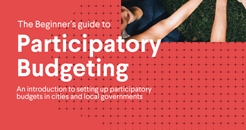 Let's continue to build community - participatory budgeting
Let's continue to build community - participatory budgeting
From a report by CitizenLab
In a previous blog on Participatory Budgeting (PB), we recognised that budgets for local authorities are tight and hard decisions have to be made about priorities. Politicians argue back and forth and no-one seems to like the outcomes. Expanding the imagination about democracy could help to focus resources on the projects that are most meaningful to local communities. Through PB, people in over 1,500 cities around the world are directly deciding how to spend public money. For example, in the US and Canada, tens of thousands of residents in over a dozen cities have used PB to allocate over $100 million to key community improvements.
Below are steps that are shared by most successful participatory budgeting processes. They are relevant regardless of the size of your city/town and the themes citizens are involved with:
Lay the groundwork
Decide which kind of PB works best for your specific situation. For example; local, specific projects with a decisive nature or city-wide, general policy ideas with an advisory nature to help prioritise.
Decide what your main goals are. For example; gaining insight into what the population prioritises, distributing budget according to what citizens have decided, giving citizens the opportunity to interact with each other, building awareness and support, giving citizens more insight in how budgeting decisions are taken.
Decide on how to engage with your citizens. This can happen both offline and online, yet offline participation can be more time and resource consuming.
Answer the following questions; What is your budget? Who can participate? Can citizens propose ideas or vote for them outside of their own neighbourhood? What are the eligibility criteria for the citizen’s ideas? What’s your idea on timing? How much time do your citizens have to
participate, and how much time will the process take in its entirety? Which topics will be covered?
Inform citizens
Citizens should be informed of the timeframe, process and rules. The eligibility criteria for ideas should be communicated clearly - if everyone knows the rules of the game, the whole process is bound to run a lot more smoothly. It’s also very important that you clearly state what the council will do with the final results: is this intended as advice or is the input decisive?
Educate your citizens by proactively communicating with them and making all the information publicly available. Not only the general documents about the PB process, but also more specific data, like the available financial resources and the budget allocation of the past year. This will help citizens make informed and data-driven decisions.
Collect input if you wish to gather project ideas from citizens
Once the PB project is launched, citizens can start commenting and, depending on the kind of project, proposing ideas. They’ll discuss local priorities and elaborate on concrete projects, all up for evaluation by the city itself. In this phase, it’s really all about the content of the ideas and not their budgetary dimensions — yet.
Decide on budgets and process input
If citizen input has been obtained, it is analysed by city experts and checked according to the eligibility criteria that were set earlier on in the process. The city selects the final proposals and gives feedback to the participants on their initial input. Similar ideas can be merged into one, retained ideas shouldn’t be concentrated in the same neighbourhood, and if you allowed votes or comments, the popularity of the ideas should also be considered
The city needs to estimate cost, technical feasibility, timeframe and plus/minus benefits of each idea.
Voting
This is where the action really starts. In this phase, citizens distribute a set budget over a number of themes or ideas. If by theme, then if you want to add to the budget in one theme, you’ll have to remove from another theme. If by ideas, you can freely add ideas from the list to your basket until the total budget of the selected ideas exceeds your budget.
After collecting and analysing the votes, the city will come up with a final budget recommendation which inspires the final decision. The ideas can then be turned into an action plan and start informing decisions.
Give your citizens at least 2 months to vote so that they have time to get informed.
Communicate the results
Communicating the results is vital. Which ideas were selected? Which domains were given the biggest share of the budget? And it’s equally important to communicate the next steps. Who will implement the selected ideas? When will this happen, and can citizens contribute in this step? How is the distribution across the different policy domains taken into account in the budget exercise of the city or municipality? Being transparent about the results is going to help build trust in the long term, and will ensure citizens participate in the next project.
Implementation
This is maybe the most essential step of all: the actual implementation. This is where citizens can see how their participation makes a real, tangible impact. Turn dreams into plans, and plans into action. And meanwhile, keep your citizens up-to-date, so they can see what’s changing.
Download guide from here.
Retweet about this article:
From a report by CitizenLab, 16/06/2020